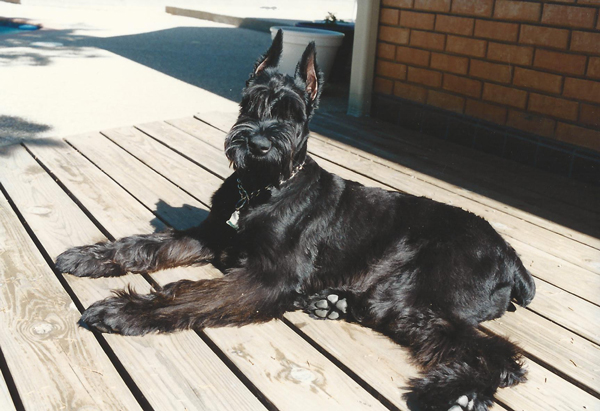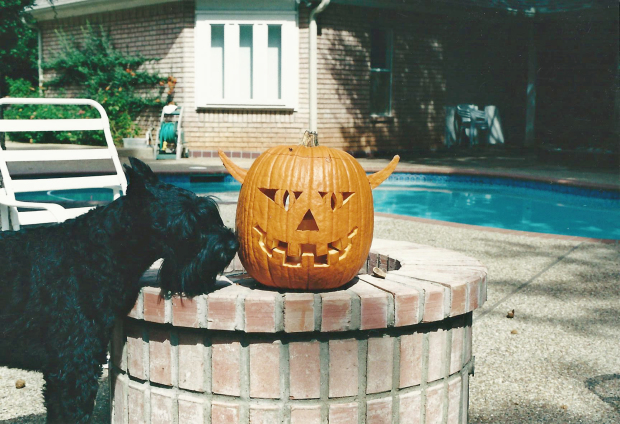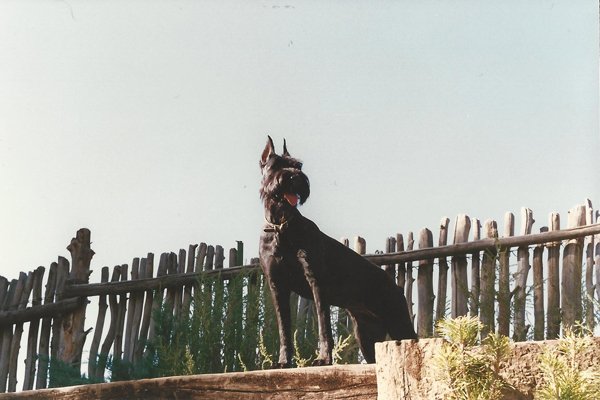As I’m sure we’ve all experienced, waiting for test results or the final outcome of a surgery (for ourselves or our giants) can often be more stressful than the surgery itself, and this certainly proved to be true for Shotz’s operation. Would she walk again? Of course, we wanted her to—for her. For us, we would love her whether she had four functioning legs or three.
On the morning of December 14, 2000, I woke with an acute case of trepidation, which worsened as I neared the clinic to pick her up. I brushed aside negative thoughts and tried to concentrate on the positive. The procedure had gone well, but according to Dr. Barstad, how well she would recover was up to Shotz and us. Some dogs, the doctor informed me, shut down and it’s not humanly possible to motivate them to get better. However, he didn’t believe this would be the case with her. She was fearless and tenacious, a fighter, but once again he cautioned me about expecting her to gain 100 percent use of the injured leg.
I tried but couldn’t hold back the tears when she came limping down the hall toward me, her right rear leg wrapped in a white padded bandage from her ankle to her upper thigh. The vet on duty said something about Shotz’s posterior cruciate being completely torn, and that the remnants of the PCL . . . Remnants? Not much else registered after that word until the vet said, “Straight-line walking for five minutes, two to three times daily, and swimming may begin in twenty-one days. Restricted exercise for eight weeks. No licking or chewing at the incision or sutures, use the E-collar at all times, and do not crate her. Allow her to fully extend the leg.” What resonated in all of this was a repeat of what Dr. Barstad had said after her first procedure: “Hopefully consistent usage of the leg by nine weeks.” These guarded comments buzzed through my tired brain as we drove home.
Within an hour of arriving at our house, Shotz destroyed her E-collar just as she had at the clinic, so I decided the best course of action was to stay glued to her until she recovered—a tall order. And since she was on steroids, she consumed large amounts of water, which meant potty breaks every two hours or so. Each trip outdoors required that I wrap her bandaged leg with plastic wrap, secure it with masking tape, then assist her in her endeavors to relieve herself. By the end of the day, we were both ready to collapse, but these potty breaks carried on throughout the night, and by daybreak we were exhausted. We kept to this regimen for three weeks.
As Shotz regained her footing and appeared to be healing well, we were able to relax and face her future with optimism—until March 7, 2001, when she (we) suffered a major setback.
In documenting Shotz’s ordeal, I wrote: “She stood up last night and began to quiver in her rear legs to the point where she was having trouble standing. She also appeared to be in pain. At this point in her recovery, as instructed, I had been walking her out and back for a mile and she had been doing well with this routine. No signs of fatigue or pain, and I never pushed her to go farther.”
On March 8, 2001, Dr. Barstad examined Shotz. The knee was stable and showed no signs of apparent damage. She was walking with a slight limp, so the prognosis was a possible strain or sprain to the repaired cruciate rupture. He prescribed Rimadyl for a week, then to take her off the medication and watch her to see if the lameness returned.
A week later we stopped the Rimadyl. Almost immediately, she started to exhibit pain, yelping every time she tried to stand. All day she vacillated between being fine one moment and in pain and stiff the next, until later that night when she began to quiver uncontrollably in her hindquarters and to whine. An hour later, if she attempted to stand, she fell over, her rear legs incapable of holding her upright.
Since her pain episodes and stilted gait were clinically suggestive of a lumbosacral problem, Dr. Barstad ordered an MRI to confirm or disprove his diagnosis. In lay terms, Shotz had a spinal infection, most likely a side effect from the leg surgery.
On March 21, 2001, Shotz underwent surgery for a bulging annulus. A dorsal laminectomy was performed. This meant Dr. Barstad delaminated and removed approximately three inches of the top section of her lower spine, “erring to the left side of the canal” to protect the spinal cord. The disk was on the verge of herniating. With the sciatic nerve retracted to the midline, the bulge was cut and evacuated with suction. He noted bruising of the left sciatic nerve. After lavage and complete hemostasis were achieved, the wound was closed.
As Shotz had undergone two major surgeries within a six-month period, we felt blessed to still have her, and finally on the road to recovery too. But Dr. Barstad warned us that after he delaminated her lower spine, then fused the vertebrae, any serious injury to her back or legs might require us to put her down. Therefore, her activities were strictly limited to horizontal movement only. No jumping, running, or climbing, just straight-line walking and only mild exercise—a really tall order for a giant.
So, we devised our own low weight-bearing program to help her strengthen her hind legs. Dave would place his hand under her abdomen to restrain her, while I swam ahead and encouraged her to swim toward me. She would kick furiously, hind legs pumping hard, trying her best to reach me, but Dave’s grip restricted her. We carried out this routine of resistance training every day for months until we noticed she was becoming steady on her feet and her gait was leveling out, with only a slight limp.
In the weeks and months of recuperation, then rehabilitation, we spent many hours together walking and swimming. To keep myself occupied on these leisurely walks, I started to carry a handheld recorder to dictate ideas for books. I wasn’t sold on a cell phone back then.
A month into these long walks along the trails at Bear Creek in Keller, Texas, the shell of a new Darcy McClain novel began to take shape, but my first chapter lacked punch—until Shotz gave me a hook. Stay tuned to future blogs to learn what that hook turned out to be.




